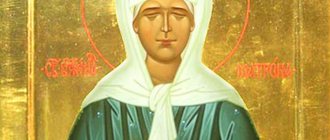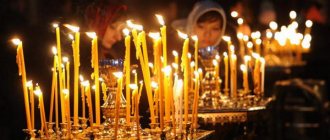| Abbess Feofania (Miskina) |
Feofaniya (Miskina)
(born 1965), abbess, abbess of the Intercession Stavropegic Convent of the City of Moscow In the world, Olga Dmitrievna Miskina, was born on July 2, 1965 in a believing family. In total, the parents had nine children, and all of them in one way or another connected their lives with serving God and people.
In 1976, the family moved to the city of Strunino, Vladimir region, from where they could get to Sergiev Posad by train in just half an hour. There was no church at all in Strunino itself, so every Saturday the whole family went to the Trinity-Sergius Lavra.
After graduating from school, she studied at the Lavra to become a regent, studied the charter, and with the blessing of her confessor, she completed evening courses in cutting and sewing, and sewed vestments.
In 1987, she entered the Koretsky convent, where she carried out general obediences in the garden, in the cowshed, painted roofs and domes, and then began to help sew bishop’s vestments.
In 1988, she was taken to Moscow to help in the Patriarchate during the celebrations dedicated to the 1000th anniversary of the Baptism of Rus'. She was a housekeeper, was responsible for supplies, sewed monastic robes, and cleaned.
On November 4, 1990, she was tonsured a monk, keeping her previous name.
In the fall of 1992, according to the petition, she was sent to the newly opened Trinity Seraphim-Diveevsky Convent. In Diveevo, she served as a storekeeper of church utensils and furniture, sewed, read and sang in the choir. She lived in the abbess’s building, and with abbess Sergia we went on supply trips, purchasing everything necessary for the restoration of the monastery.
On February 22, 1995, she was appointed abbess of the Intercession Convent in Moscow.
On April 14, 1995, she was tonsured a monk and given the name in honor of the blessed Queen Theophania by Patriarch Alexy II of Moscow and All Rus' in the Cross Church of the Vladimir Icon of the Mother of God of the Moscow Patriarchate.
On April 4, 1998, she was elevated to the rank of abbess by Patriarch of Moscow and All Rus' Alexei II.
On May 1, 2002, she received the abbot's staff from the hands of Patriarch Alexy II of Moscow and All Rus'.
Achilles
Views: 12,092
Dmitry Gorevoy, religious scholar, director of the public organization “Center for Religious Security” - for Vot-tak.tv
The abbess of the Intercession Monastery in Moscow, Abbess Feofania (Miskina), yesterday (the material was published on July 14 - Achilles' note) found herself at the center of a scandal. Journalists from Open Media found a Mercedes-Benz S-Class worth 9.5 million rubles in the nun’s possession. This is not the first such car: Feofaniya has already bought a car of this brand before. We are talking about a woman who refused to give money to a priest for her son’s treatment; the child subsequently died.
(Don't) help your neighbor
But in church circles, Feofaniya is known not only as the successful abbess of the largest Moscow monastery. In February of this year, an unpleasant situation arose in the monastery of the abbess. The young priest Alexei Golubev’s seven-month-old son Kostya fell ill.
The child was diagnosed with liver and heart pathology. It took two operations at once. Russian doctors refused to take care of the baby and advised the operation to be performed in Belgium, where such children are successfully treated. The total cost is 23 million rubles ($320 thousand).
Journalist Marina Akhmedova was the first to report the priest’s plight. The priest confessed to her mother. On February 4, 2021, the journalist launched a campaign to raise funds for the child’s treatment. After Akhmedova’s publication, a discussion began about why the priest is collecting money on the Internet, but the monastery in which he serves is not helping.
And priest Golubev served at that time in one of the richest monasteries in Moscow - the Pokrovsky convent on Taganka. This is where the relics of Saint Matrona are located. The Matronushka cult, successfully promoted by the church authorities, brings hundreds of thousands of believers to the monastery. In addition, the monastery has a shop with a wide variety of jewelry paraphernalia, as well as an expensive hotel.
Experts claim that the monastery earns about 1 million rubles a day, that is, an amount of 23 million rubles can be collected in a little more than 3 weeks. Church telegram channels write that the priest turned to Abbess Feofania for help, but she refused and did not even allow public fundraising at the monastery.
Amid the fundraising campaign for the monastery, more and more questions arose. The main thing, of course, is why the richest monastery will not help its own priest in distress? After 9 days - on February 13 - due to media outcry, the priest was simply fired from the monastery. He was summoned to the office of Feofania’s assistant Anastasia and told that the monastery had no money and could not help. The reason for the dismissal was given as “publications on the Internet.”
This provoked an even bigger scandal. On February 19, the Patriarchate transferred Father Alexei to another monastery - the Martha and Mary Convent of Mercy for a period of one year. The monastery was also entrusted with the responsibility “to have special care for the priest’s family and himself, who are in difficult and sorrowful life circumstances.”
However, just three days later - on February 22 - it became known that the priest’s son Kostya Golubev had died. On the same day, Patriarch Kirill presented Abbess Feofania for an award - the Church Order of Euphrosyne of Moscow, 3rd degree, for “special zeal and responsibility” in the position of abbess of the monastery.
It turns out that on the day when the baby died due to the fact that he was not given the necessary treatment in time, the nun, who, apparently, had the necessary funds, but refused, receives an order from the patriarch for special responsibility.
Church-feudal order
However, no matter how wild and terrible this episode may seem, it, alas, is part of reality for the modern Russian Orthodox Church. A disregard for their own employees is one of the characteristics of the abbots of large churches and monasteries, not to mention bishops.
Priest Golubev, like hundreds of other vulnerable priests, ran to church services, confessed, baptized, married, and generally worked for the good of the monastery, while his six-month-old baby was examined. Instead of being with his wife and child, he worked.
And how did his superiors respond to such self-sacrifice? But in no way - it was chewed and spat out from the monastery. And there are many such stories in the church. For a long time, the topic of exploitation of ordinary clergy by influential superiors was kept under wraps. But at a critical moment it broke through. This is how the Achilles website arose, which anonymously publishes stories from the lives of ordinary priests.
Maria Kikot recently wrote about monastic order, the use of monks as cheap labor, humiliation, psychological and physical violence. The book with the telling title “Confession of a former novice” describes the modern realities of Russian monasteries.
But neither the appearance of Achilles, nor Confession, nor other rebel resources affected the situation. The leadership delegates the solution of local problems to regional bishops and metropolitans in exchange for stable contributions to the central church budget. It is the regular flow of money that provides peace of mind to local hierarchs. The Church in Russia has turned into feudal principalities, where the vassals of the patriarch have absolute power in their fiefs.
A straw in someone else's eye
That is why Abbess Feofaniya did not pay anything for her absolutely inhumane act towards her cleric. On the contrary, she also received an order. Probably because she regularly contributed the required amount to the patriarchate.
Love, mercy, compassion, help and mutual assistance - all that the church must teach in order to be the moral authority of society. But, apparently, in practice, for people in cassocks these are all empty words. Bureaucracy has defeated the Gospel. The system of exactions supplanted the teachings of Christ. At the same time, you will hardly hear criticism of all this from the lips of representatives of the Russian Orthodox Church.
But talk about the “spiritual West” can be heard from almost every second pulpit. A church that condemns the straw in someone else's eye and simply does not notice the warehouse of logs in its own. Unfortunately, this has already happened in the history of the Russian Church and ended in 1917, when yesterday’s believers themselves tore down the bells and dismantled the domes. It seems that the Moscow Patriarchate as a church institution is confidently heading towards its own disaster.
Photo: pokrov-monastir.ru
If you like our work, support us:
Sberbank card : 4276 1600 2495 4340 (Pluzhnikov Alexey Yurievich)
Or using this form, entering any amount:
[edit] Biography
In 1976, the family moved to the town of Strunino, Vladimir Region, from where they could get to Sergiev Posad by train in just half an hour. There was no church at all in Strunino itself, so every Saturday the whole family went to the Holy Trinity Sergius Lavra. They stayed there overnight and attended church services in the morning. We confessed to one of the Lavra hieromonks, Fr. Polycarp, who became the confessor of the whole family.
After graduating from school, Olga Miskina studied at the Lavra to become a regent, studied the charter, and with the blessing of her confessor, she completed evening courses in cutting and sewing, and sewed vestments.
In 1987 she entered the Koretsky Convent. Here novice Olga carried out general obediences in the garden, in the cowshed, painted roofs and domes, and then began to help sew bishop’s vestments.
In 1988, novice Olga was taken to Moscow to help in the Patriarchate during the celebrations dedicated to the 1000th anniversary of the Baptism of Rus'. She was a housekeeper, was responsible for supplies, sewed monastic robes, and cleaned.
On November 4, 1990, on the feast of the Kazan Icon of the Mother of God, she was tonsured a monk, leaving her former name.
On March 24, 1990, in connection with the 400th anniversary of the establishment of the Patriarchate in Rus', she was awarded the medal of the Russian Orthodox Church of the Holy Blessed Prince Daniel of Moscow by His Holiness Patriarch Pimen of Moscow and All Rus'.
In the fall of 1992, with the blessing of His Holiness Patriarch Alexy II, according to the petition, nun Olga was sent to the newly opened Holy Trinity Seraphim-Diveevo Convent, as she loved St. Seraphim of Sarov very much. In Diveevo, she served as a storekeeper of church utensils and furniture, sewed, read and sang in the choir. She lived in the abbess’s building, and with abbess Sergia we went on supply trips, purchasing everything necessary for the restoration of the monastery.
02/22/1995 By decree of His Holiness Patriarch Alexy II, she was appointed abbess of the Intercession Convent in Moscow.
It was she who in the 1990s began to seek the canonization of the blessed elder Matrona of Moscow.[1]
On April 14, 1995, she was tonsured a monk by His Holiness Patriarch Alexy II of Moscow and All Rus' in the Cross Church of the Vladimir Icon of the Mother of God of the Moscow Patriarchate with the name Feofania in honor of the blessed Queen Theophania.
As Open Media writes, Feofania did everything to ensure that as many believers as possible learned about the cult of Matrona: by order of the Intercession Monastery, they began to produce audio materials and films about the miracles of the saint, as well as books about her life, including for children.
Over time, this led to the fact that Matrona became one of the most revered saints of Russia; thousands of pilgrims began to come to the monastery every day to venerate her relics, and it became the richest monastery of the Russian Orthodox Church.[1]
Also
Feofania built a five-star hotel with a swimming pool, fitness center and bath complex near the monastery, and also repeatedly tried to annex the territory of Tagansky Park, which was laid out in the 1930s on the site of the former monastery cemetery, to the monastery.[1]
On July 30, 2018, she was appointed acting general director of the Danilovskaya Russian Orthodox Church Hotel.[2]
[edit] Awards
On October 13, 1996, she was awarded a pectoral cross by His Holiness Patriarch of Moscow and All Rus' Alexei II.
On April 4, 1998, she was elevated to the rank of abbess by His Holiness Patriarch of Moscow and All Rus' Alexei II.
05/01/2002 she was awarded the monastery rod as the abbess of the monastery by His Holiness Patriarch Alexy II of Moscow and All Rus'.
On November 22, 2003, she was awarded the right to wear a cross with decorations by His Holiness Patriarch Alexy II of Moscow and All Rus'.
In 2005, for the restoration of the Intercession Monastery and the revival of monastic life in it, she was awarded the national award “Person of the Year 2005”.
01/24/2012 His Beatitude Theodore, Patriarch of Alexandria and All Africa, was awarded the Order of the Holy Apostle Mark.
In 2014 she was awarded the memorial badge “700th anniversary of St. Sergius of Radonezh" by His Holiness Patriarch Kirill of Moscow and All Rus'.
In 2015, in recognition of her hard work for the benefit of the Church and in connection with her 50th birthday, the abbess of the Intercession Stauropegial Convent in Moscow, Abbess Feofaniya (Miskina), was awarded the Order of the Holy Equal-to-the-Apostles Princess Olga, II degree.
Church-feudal order
However, no matter how wild and terrible this episode may seem, it, alas, is part of reality for the modern Russian Orthodox Church. A disregard for their own employees is one of the characteristics of the abbots of large churches and monasteries, not to mention bishops.
Priest Golubev, like hundreds of other vulnerable priests, ran to church services, confessed, baptized, married, and generally worked for the good of the monastery, while his six-month-old baby was examined. Instead of being with his wife and child, he worked.
And how did his superiors respond to such self-sacrifice? But in no way - it was chewed and spat out from the monastery. And there are many such stories in the church. For a long time, the topic of exploitation of ordinary clergy by influential superiors was kept under wraps. But at a critical moment it broke through. This is how the Achilles website arose, which anonymously publishes stories from the lives of ordinary priests.
Abbess Feofaniya (Miskina) and Patriarch Kirill visit the farmstead farmstead. Photo: Sergey Vlasov / mbrsm.ru
Maria Kikot recently wrote about monastic order, the use of monks as cheap labor, humiliation, psychological and physical violence. The book with the telling title “Confession of a former novice” describes the modern realities of Russian monasteries.
But neither the appearance of Achilles, nor Confession, nor other rebel resources affected the situation. The leadership delegates the solution of local problems to regional bishops and metropolitans in exchange for stable contributions to the central church budget. It is the regular flow of money that provides peace of mind to local hierarchs. The Church in Russia has turned into feudal principalities, where the vassals of the patriarch have absolute power in their fiefs.









